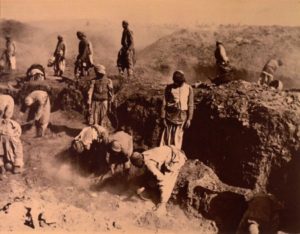
El-Behnesa, Egypt, 1896. There was little to see. It was a landscape of windblown sand surrounding a sleepy arab village. But for Bernard P. Grenfell and Arthur S. Hunt, young English scholars of classicism from the Queen’s College in Oxford, there was something about the place that screamed at them. Set astride a small river that anciently served as a canal of the Nile, they knew it was the location of two ancient cities, the more ancient called Per-Medjed, a capital of the Egyptian 19th Dynasty, and the younger called Oxyrhynchus Polis (meaning “City of the Sharp-Nosed Fish”), a Greco-Roman town initially under the Ptolemaic rulership of 3rd-1st century B.C. Egypt. But all that could be seen of them today was a lone, well-weathered Greek column and a few traces of stone-lines and banks of sand that only hinted at the city’s ancient presence. 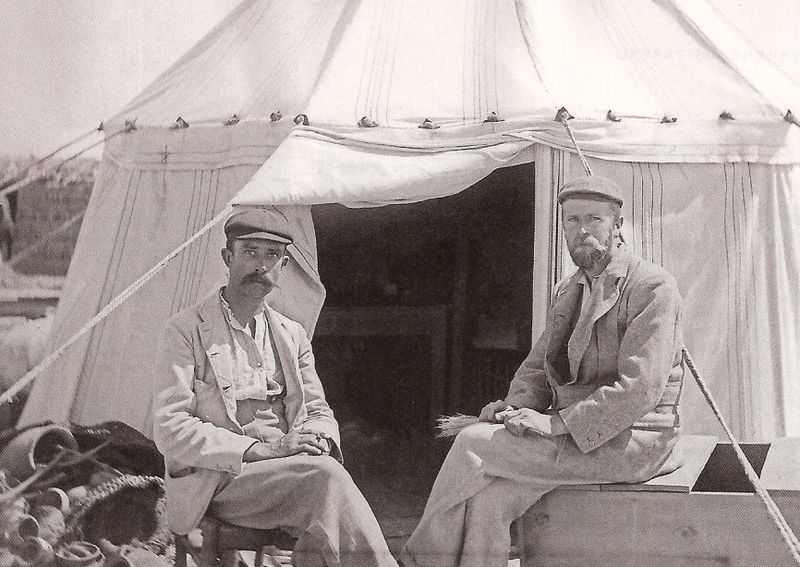 The site was nothing like the visual splendor that greeted explorers and adventurers at places like Luxor, Giza, and Abu Simbel.
The site was nothing like the visual splendor that greeted explorers and adventurers at places like Luxor, Giza, and Abu Simbel.
But Grenfell and Hunt (pictured right) were not interested in architecture. They were interested in researching ancient papyri, and having recently excavated in the Fayum area, the region surrounding the well-known ancient Egyptian site of Crocodilios, they had hopes that this new, relatively obscure site might yield something significant.
The Motherlode
As it turned out, they were right……but far more than they had ever imagined.
Securing the help of 200 local men from the nearby village of El-Behnesa, they began digging into mounds that anciently served as garbage dumps for the refuse of centuries of succeeding human generations. For a thousand years, the inhabitants of ancient Oxyrhynchus had dumped their garbage in mounds outside the city, and for another thousand years, the intensely dry climate and winds of sand had covered them into oblivion.
The digging was not easy. Battling strong winds and blowing sand that stung the skin and threatened the eyes, they toiled undaunted through an Egyptian winter season, digging down inch by inch until their efforts were finally rewarded in January of 1897.
They found papyrus. It began as a trickle. Then the site generously yielded one papyrus fragment or bundle after another until the layers seemed to virtually flow with papyri.
The first major find to emerge from the sand was a papyrus that contained, in Greek script, what was later translated as the Gospel of Thomas, an apocryphal work that was never canonized into the New Testament of the Bible. Three manuscripts were unearthed. They are to this day the only known manuscripts of the Gospel of Thomas in Greek. The only other manuscript was written in coptic, discovered later among the finds at Nag Hammadi, also in Egypt. A fragment of the Gospel of Matthew followed soon after. The finds were astonishing, not so much because of the biblical references, but because of the sheer mass of the discovery. By the time Grenfell and Hunt’s excavations had ended in 1907, there were enough papyri to fill 700 boxes, a total of 500,000 fragments that made their way back to Oxford, England, for preparation and study.
________________________________
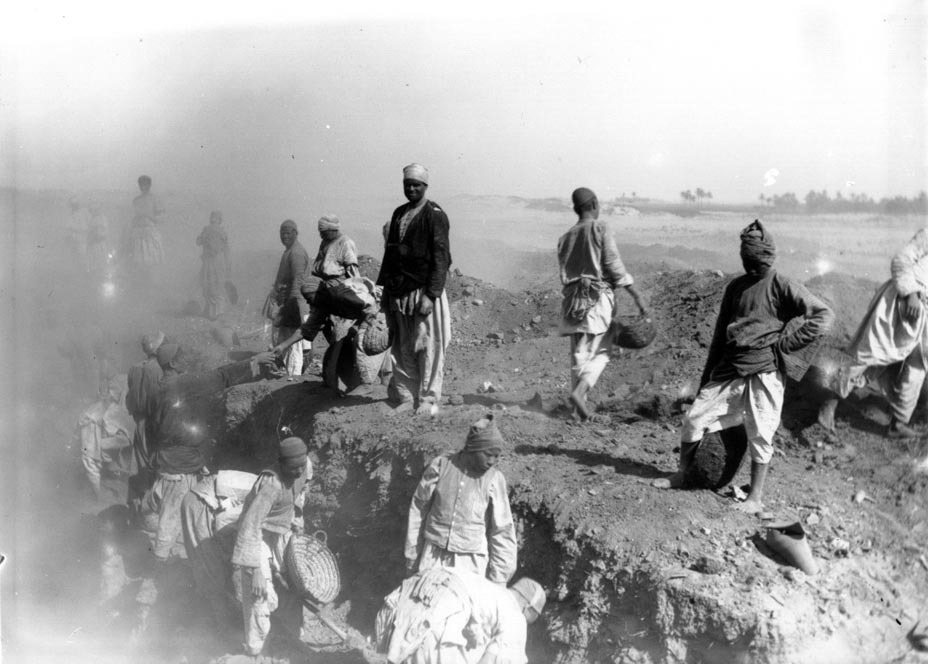 Excavating papyri at Oxyrhynchus. Courtesy Egypt Exploration Society
Excavating papyri at Oxyrhynchus. Courtesy Egypt Exploration Society
___________________________________________________
During the summers between seasons, Grenfell and Hunt labored over cleaning, sorting, identifying and deciphering the meaning of the hundreds of thousands of fragments uncovered. As scholars, they were hoping to acquire works, known, unknown, and lost, of classical Greek literature. They were not disappointed. They uncovered fragments of the works of the playwright Menander, Sophocles, Satyrus, Euclid, and latin works by Livy. More Christian texts, too, were among the major finds, including parts of Matthew, John, Mark, Romans, the Book of Revelation, the Apocalypse of Baruch and the Gospel according to the Hebrews, and parts of the Old Testament.
__________________________________________________________________________________________________________________________
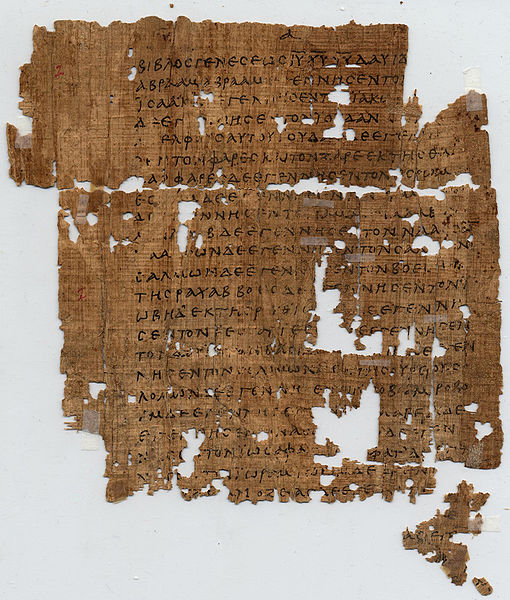 From the Gospel of Matthew. Public Domain, Wikimedia Commons
From the Gospel of Matthew. Public Domain, Wikimedia Commons
_____________________________________________________________________________________________________________________
But only 10 percent of the finds were literary. Roughly 70 percent consisted of public and private documents such as codes, edicts, official correspondence, census returns, tax assessments, petitions, court records, bills of sales, leases, wills, inventories, and even horoscopes and private letters. Excavations continued by an Italian team from 1910 to 1934 added many more finds to the inventory. It was, most importantly and without question, the most detailed and intimate account of the lives and times of an ancient people of an ancient city. It was an unprecedented window into the past, unmatched by any other archaeological undertaking.
In 1898, Grenfell and Hunt published the first volume of the finds. They continued to translate and publish until 1934, when Hunt died after continuing the work with others following Grenfell’s death in 1920. Translation work has continued since the 1930s, and for more than twenty years the work has been performed under the supervision of Professor Peter Parsons of Oxford University. More than seventy five volumes of the Oxyrhynchus Papyri have thus far been published. The volume of finds was so great, however, that new volumes will continue to be published (at a rate of one volume a year), and translation of the many thousands of fragments left for study continue to promise work for scholars for years to come. Recently, a collaborative effort has been launched by a consortium of universities, museums, and scholars to expedite the translation work. Called the Ancient Lives Project, it is coordinated under the auspices of the Citizen Science Alliance and invites the public to get involved in the work through a web-based process at the Ancient Lives website. The documents, housed in the electronic database of Oxford University’s Imaging Papyri Project, can be viewed free of charge by anyone online.
_______________________________
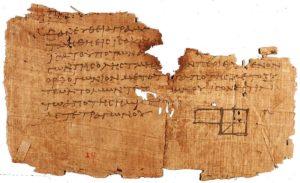
Oxyrhynchus papyrus (P.Oxy. I 29) showing fragment of Euclid’s Elements. Public Domain, Wikimedia Commons
_______________________________
_______________________________________________________________________________
Private Lives
It has been estimated that over 70 percent of the world’s literary papyri come from Oxyrhynchus. For many, however, the greatest value lies in the numerous fragments and documents that detail the ordinary, even mundane, aspects of living in ancient Greco-Roman Egypt. More than any other group of papyrus finds, the Oxyrhynchus papyri have offered the world an intimate glimpse into the personal lives and business dealings of a people and culture long departed. 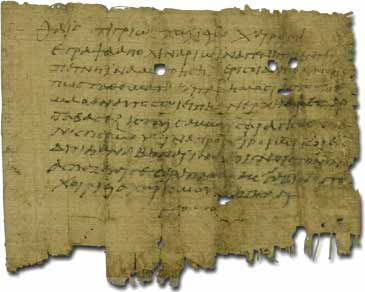 For today’s scholars of history, anthropology, and history, and particularly for the rest of humanity living lives of little public consequence and notoriety, the papyri carry a meaning that transcends the traditional fascination or interest in the great people and events of conventional written history. This is realized in the volumes of recovered transactions, dealings, accounts and letters (example pictured right) that documented the everyday lives of the people of Oxyrhynchus Polis, lives that but for the papyri would have been lost and forgotten for posterity.
For today’s scholars of history, anthropology, and history, and particularly for the rest of humanity living lives of little public consequence and notoriety, the papyri carry a meaning that transcends the traditional fascination or interest in the great people and events of conventional written history. This is realized in the volumes of recovered transactions, dealings, accounts and letters (example pictured right) that documented the everyday lives of the people of Oxyrhynchus Polis, lives that but for the papyri would have been lost and forgotten for posterity.
Consider, for example, the following letter excerpt written by one named Hilarion to his wife. He is residing for a time in Alexandria, Egypt, while his wife remains at a distant location. He discusses a family matter of finance and pending childbirth, with an interesting cultural or personal twist that would be considered unthinkable for many in today’s modern culture:
Know that we are still even now in Alexandria. Do not worry if they all come back and I stay in Alexandria. I urge and beg you, be concerned about the child and if I receive my wages soon, I will send them to you. If by chance you give birth, if it is a boy, let it be, if it is a girl, throw it out. You have said to Aphrodisias, “Do not forget me.” How can I forget you? So, I urge you not to worry.
POxy 744, The Oxyrhynchus Papyri
And the following letter fragment, alluding to the activities of a one-eyed astrologer, makes one wonder what was done to Serenilla:
‘. . . I withdrew and went to sleep, and I sent the astrologer — the one-eyed one (monophthalmon) — to call you and he said that he could not find you. At lamp-lighting I returned and when I heard from Serenilla the things that you had done to her I was upset that you behaved in a way unworthy of you. So receive her kindly up there before the (end of the?) festival. And I would have been there already had I not been ‘dog-devoured’ (kunobrotos, i.e. bitten by a dog?) on the very day of the rise of the Dog star, the 25th, by a mad dog, and until now I . . . terribly . . .’.
The Oxyrhynchus Papyri vol. LXI no. 4126
The following letter fragment about a meeting says something about the important role that astrology might have played (as is also alluded in the letter fragment above) in the every day thinking or lives of people in the Greco-Roman world:
‘Elis to his most esteemed Carpus, very many greetings. Don’t forget about the order for the three plates, two big ones and (one line missing here, perhaps ‘and one small one’));. … meet (or: make a contract with) your friend when the Moon is in Sagittarius, at the 4th hour; it arrives there on 12th Thoth; it is there again also on the 13th and 14th until the 7th hour. At these times meet (or: make a contract with) your friend. Farewell.’
The Oxyrhynchus Papyri vol. LXV no. 4483
And the following repudiation of a betrothal by the potential bride’s father reminds us that fathers’ feelings for their daughters have never changed:
‘. . . eleventh indication. I John, father of Euphemia, my unemancipated daughter, do send this present deed of separation and dissolution to you, Phoebammon, my most honourable son-in-law, by the hand of the most illustrious advocate Anastasius of this city of Oxyrhynchus. It is as follows. Forasmuch as it has come to my ears that you are giving yourself over to lawless deeds, which are pleasing to neither God nor man, and are not fit to be put into writing, I think it well that the engagement between you and her, my daughter Euphemia, should be dissolved, seeing that, as is foresaid, I have heard you are giving yourself over to lawless deeds and that I wish my daughter to lead a peaceful and quiet life. …’’
The Oxyrhynchus Papyri, Vol 1, CXXXIX
It is easy to forget that history is made up of real people, complete with all of the foibles, issues, opinions, needs, and loves that color the lives of ordinary people everywhere, at every place and time in world history. The world, even over 2,000 years ago, had personality…….they were, in most respects, like us.
Biblica Non Grata
Among the most sensational finds of the Oxyrhynchus excavations were the fragments of biblical texts that were unearthed and subsequently translated and published for the world’s eager biblical scholars and lay person alike to study and peruse. Like the Nag Hammadi and Dead Sea Scroll finds that followed later in the century, they grabbed headlines and the published volumes of text lined the bookshelves of those who were serious enough to absorb their content.
More engaging and curious still, were the mysterious Gospel writings that opened additional windows on the man Jesus — the man who, for much of the global population, forever changed the world more than any man in history.
Very early in the excavations the first such papyrus emerged and, once translated, captured the attention of scholars and, soon, a fascinated public. Grenfell and Hunt called it Logia Iesu or the “Sayings of Jesus” (Papyrus Oxyrhynchus 1, or POxy 1), because of the monologue clearly identifiable to that of Jesus of the canonized Gospels of the New Testament. Fifty years later, nearly identical lines were found written in coptic among papyrus codices found at Nag Hammadi, Egypt, this time in a complete copy of the Gospel of Thomas, a work that was hidden away by monks because the writings were considered heretical. Thus, unbeknownst to them at the time, Grenfell and Hunt were the first to discover the lost Gospel of Thomas.
Equally intriguing was a find made by Grenfell and Hunt during their sixth season of excavations. It was a small parchment book containing writings from a gospel still unknown to this day. Known by scholars as POxy 840, it recounts a dialogue between Jesus and a Pharisaic priest upon entry of Jesus and his disciples into the sacred precinct of the Second Century Temple of Jerusalem:
And he took them [the disciples] and went into the place of purification itself and walked around in the Temple. And a certain Pharisee, a high priest named [ ] approached them and fell in with them and said to the savior, “Who allowed you to set foot in this place of purification and look upon these holy vessels when you have not bathed and your disciples have not even washed their feet? In spite of being unclean, you have set foot in this temple which is clean, in which no one may walk unless he has bathed and changed his clothes, nor dare to look at these holy vessels.”
And standing with his disciples, the savior answered him, “Then are you, being in the Temple, clean?”
He [the Pharisee] said to him, “I am clean, for I have bathed in the pool of David. I went down into it by one flight of stairs and came up out of it by another. Then I put on clean, white clothes. Only then did I come and view these holy vessels.”
The savior answered him, “Woe to the blind who cannot see! You have bathed in these gushing waters, in which dogs and pigs lie night and day! And you have washed and scraped the outer layer of skin, just where prostitutes and flute girls anoint, bathe, cleanse and adorn in order to arouse the desires of men—but they are filled with scorpions and all kinds of evil on the inside. But I and my disciples, whom you say have not washed, have been dipped in waters [ ]………
The Oyrhynchus Papyri, POxy 840
These exact lines and the mysterious gospel source from which they came have not been found in any other ancient context. The discovery is unique to Oxyrhynchus.
__________________________________

Papyrus Oxyrhynchus 1. Public Domain, Wikimedia Commons
__________________________________
What Lies Beneath
The Greco-Roman city of Oxyrhynchus, and the older Egyptian city that lies beneath it, have never been extensively excavated because the modern town of el-Bahnasa has been built above it. Any excavations would, therefore, be surgical in nature. If full-scale excavations could be conducted, there is little doubt that much would be uncovered as it was, during Hellenistic times, the third largest city in Egypt and served as a regional capital. After the introduction of Christianity, it became a prominent location for churches and monasteries and became the seat of a bishopric. It is therefore known to have featured a number of public buildings, including a hippodrome, a gymnasium, public baths, a theatre with a capacity for 11,000 people, and likely military buildings as it was a site for military garrisons stationed during the Roman and Byzantine periods. It was graced with an abundance of temples during the Greek and Roman periods, including temples to Demeter, Dionysus, Apollo, Hermes, Serapis, Osiris, Zeus-Amun, Hera-Isis, Mars, and Jupiter-Capitolinus.
A number of artifacts other than papyrus have been excavated from the surrounding ancient refuse mounds. The massive amount of work that remains to be done on the un-translated papyrus texts, however, and the potential archaeological bonanza that still lies beneath the modern town (if someday accessible), speaks volumes about the untapped knowledge and adventure of discovery that awaits future archaeologists, scholars, and a visiting public. If you read ancient Greek or Latin, you can play a direct personal role in that process by going to the Ancient Lives Project website. If you are an archaeologist or student of archaeology, you may one day play a part in uncovering more of the ancient city herself.
______________________________________________________
Cover Photo, Top Left: Excavators hard at work at the site of Oxyrhynchus. Courtesy Egypt Exploration Society.
Photo, Second from Top, Right: Bernard Grenfell and Arthur Hunt. Public Domain
Photo, Ninth from Top, Right: A papyrus private letter found at Oxyrhynchus. Public Domain.
_______________________________________________________________________________________________________________________
Receive 30 days free access to the popular new CuriosityStream lineup of documentaries on science, history, nature, and technology as a new Popular Archaeology premium subscriber.
___________________________________________
Travel and learn with Far Horizons.
____________________________________________
This richly illustrated issue includes the following stories: Recent findings shedding new light on the whereabouts of the remains of Philip of Macedon, father of Alexander the Great; how an archaeologist-sculptor is bringing bones of the dead back to life; archaeologists uncovering town life at the dawn of civilization; an exclusive interview with internationally acclaimed archaeologist James M. Adovasio about what makes the Meadowcroft Rockshelter prominent in the ongoing search for the first Americans; what archaeologists are finding at the site of the ancient city of Gath, the home town of the biblical Philistine giant, Goliath; and how scientists are redrawing the picture of human evolution in Europe. Find it on Amazon.com.







